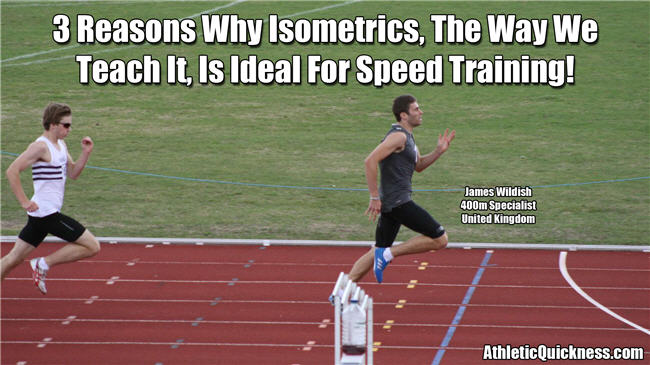3 Reasons Why Isometrics, The Way We Teach It, Is Ideal For Speed Training!
The training does not mix endurance or strength training with speed training, so it can focus soley on the factors that make it a pure speed training program.
First, what is meant by muscle contraction speed?
Use the biceps muscle in your arm for an example. When your arm is stretched out straight, your biceps muscle is stretched. Now move your fist towards your shoulder. What has happened? Your biceps muscle contracts thus moving your fist toward your shoulder. Obviously, the faster your muscle contracts, the faster your fist will move. When your biceps muscle is programmed to instantly contract to a certain position, you have then achieved lightning-like speed.
Muscle contraction speed is the principle behind speed in all of your athletic skills… running, jumping, kicking and swinging a bat, tennis racket or golf club, for example.
The types of fibers in your muscles that create this type of speed are called fast twitch muscle fibers. They are not the same as strength and endurance fibers and therefore need to be conditioned separately. You cannot condition your muscles for quickness the same way you condition your muscles for strength.
Reason 1) Time Required For Training
Our research has shown that fast twitch muscle conditioning takes place within the first 10 minutes of isometric training only.
After that, your body’s own physiologic processes will start recruiting slow twitch fibers to complete the training, which is contrary to speed and quickness. The longer your body is involved in slow twitch training, the less fast your muscles become.
Speed training should, as the term implies, be fast. If your current speed training routine takes longer than 15 minutes to complete, you are NOT training for speed but, rather, you are training for strength and endurance.
Most speed training programs on the market take about 45 minutes to an hour to perform. Even if you performed our program for more than 10 minutes, you will start conditioning your muscles for strength and endurance and not speed.
This is perhaps the hardest thing for competitive athletes to grasp, and that is, to limit the amount of time for speed training to just 10 minutes.
Reason 2) Repetitions
All other speed training programs require your muscles to perform repetitions, whether it’s by running, lifting weights, jumping up and down off of boxes or running down a track with parachutes and/or weight sleds. Repetitions build strength and endurance within muscles, not speed.
Again, our research has shown that when muscles are forced to go through repetitions where the length of the muscles are constantly changing, the body’s fast twitch muscle fibers are completely ignored for speed, resulting in a strength and endurance training program and not a speed of contraction routine.
If this all sounds a little confusing consider this: If all you had to do to run faster was to go out and run, then each time you ran, you should be faster than the previous time out. But, we all know this is not true. This is because running more does not make you faster; but, rather, it improves your strength and endurance to run longer.
Isometric training does not require repetitions in the traditional sense. Instead, muscles are locked into a position for a given period of time forcing your body to recruit those much needed fast twitch fibers that are almost always ignored for their natural ability of speed with other types of training (for example, plyometrics, weight training, etc.).
Reason 3) Resistance Bands
Isometric Training using a resistance band adds an additional element of muscular contract speed to the workout.
Here’s why: Weights rely upon gravity to produce resistance. A stretched elastic band has much more stored acceleration energy than gravity does. No matter how much weight is being used, a stretched elastic band has much more potential acceleration than a raised weight. This is why a stretched elastic band will contract at high speed when released.
During an isometric exercise using a stretched band as resistance, the stored acceleration energy of the band is transferred into your muscles.
Also, by using a stretched elastic band for resistance, the exact muscles used in an athletic skill can be targeted and the precise motion involved in that skill can be closely duplicated during the exercise.
This means that the muscles involved in an athletic skill, swinging a bat for example, are conditioned and programmed for speed in the same motion used when performing the skill.
The end result is faster contracting muscles, all the time, without exception. And this translates into greater speed and performance in football, basketball, baseball, soccer, tennis, golf, and just about any other sport you can think of.






